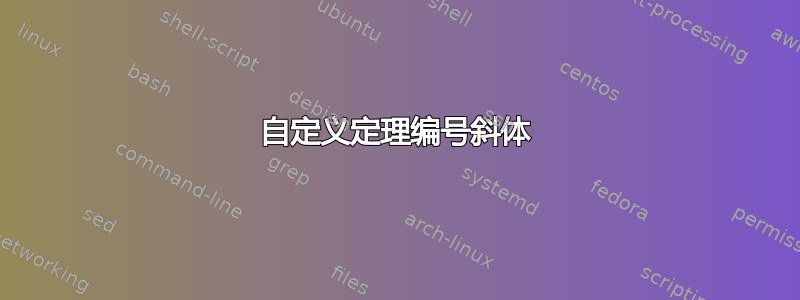
在自定义定理编号@egreg 为我们提供了一种在定理上添加自定义标签的方法。但是,当我使用该新命令编译我的 latex 文档时,定理的文本是常规文本。如果我想将其改为斜体文本,我应该如何修改该命令?
编辑:在我的乳胶文档的顶部,我有
\documentclass[11pt]{article}
\renewcommand{\baselinestretch}{1.05}
\usepackage{amsmath,amsthm,verbatim,amssymb,amsfonts,amscd, graphicx,tikz}
\usetikzlibrary{calc, shapes, cd, backgrounds}
\usepackage{graphics}
\usepackage{titlesec}
\setcounter{secnumdepth}{4}
\titleformat{\paragraph}
{\normalfont\normalsize\bfseries}{\theparagraph}{1em}{}
\titlespacing*{\paragraph}
{0pt}{3.25ex plus 1ex minus .2ex}{1.5ex plus .2ex}
\topmargin0.0cm
\headheight0.0cm
\headsep0.0cm
\oddsidemargin0.0cm
\textheight23.0cm
\textwidth16.5cm
\footskip1.0cm
\theoremstyle{plain}
\newtheorem{theorem}{Theorem}
\newtheorem{corollary}{Corollary}
\newtheorem{lemma}{Lemma}
\newtheorem{proposition}{Proposition}
\newtheorem{conjecture}{Conjecture}
\newtheorem*{question}{Question}
\theoremstyle{definition}
\newtheorem{definition}{Definition}
\newtheorem*{remark}{Remark}
\newtheorem*{example}{Example}
\newtheorem{problem}{Problem}
\newtheorem{exercise}{Exercise}
\newtheorem{innercustomthm}{Theorem}
\newenvironment{customthm}[1]
{\renewcommand\theinnercustomthm{#1}\innercustomthm}
{\endinnercustomthm}
\begin{document}
然后,当我使用“\begin{theorem}”插入定理时,编译后的版本会以斜体显示。现在,我想使用链接中概述的自定义编号系统。但是当我按照该答案操作时,生成的文本不会以斜体显示。
如果我写
\begin{theorem}
This is a theorem.
\end{theorem}
我明白了
定理1。 这是一个定理。
但如果我在顶部输入新命令
\newtheorem{innercustomthm}{Theorem}
\newenvironment{customthm}[1]
{\renewcommand\theinnercustomthm{#1}\innercustomthm}
{\endinnercustomthm}
然后我输入
\begin{customthm}{1.1}
This is a theorem.
\end{custom}
我明白了
定理 1.1。这是一个定理。
我想让正文部分以斜体显示。
编辑 2:我添加了文档的标题。抱歉,我的无知——我从模板中复制了标题,但我不知道如何调整它的细节。
答案1
问题是,之前最近的\theoremstyle调用\newtheorem{innercustomthm}{Theorem}是\theoremstyle{definition},因此innercustomthm采用了定义的样式,即直立文本。您可以通过移动到\newtheorem{innercustomthm}{Theorem}所有其他定理声明之前来解决这个问题,这将使其具有默认的斜体样式。
例如:
\documentclass[11pt]{article}
\usepackage{amsmath,amsthm}
\newtheorem{innercustomthm}{Theorem}
\theoremstyle{plain}
% ... other theorem declarations (same as before)
\newtheorem{exercise}{Exercise}
\newenvironment{customthm}[1]
{\renewcommand\theinnercustomthm{#1}\innercustomthm}
{\endinnercustomthm}
\begin{document}
\begin{customthm}{1.1}
This is a theorem.
\end{customthm}
\end{document}



